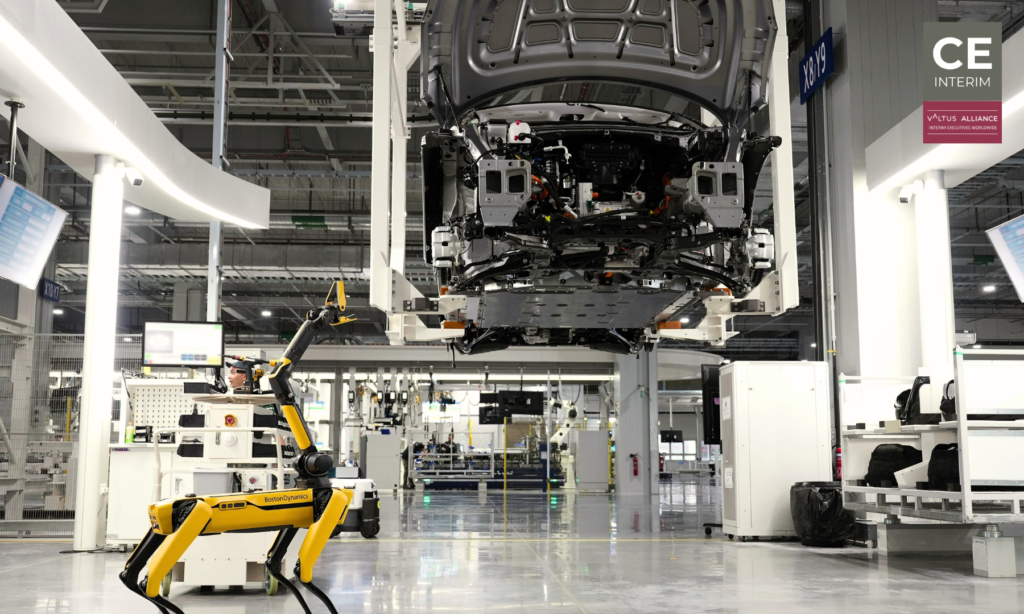Corridoio VIII e Bulgaria: la porta orientale per l'industria

Scoprite perché il Corridoio VIII sta trasformando la Bulgaria nella centrale logistica dell'Europa sudorientale e cosa significa per produttori e investitori.
Cosa spinge Rheinmetall e i giganti tecnologici a trasferirsi in Bulgaria?

Rheinmetall, Liebherr e i giganti della tecnologia si stanno espandendo in Bulgaria. Scoprite i veri fattori che stanno alla base del polo industriale europeo in più rapida ascesa.
$500B Iniziativa Stargate: Sfide per l'industria europea

Scoprite come l'iniziativa $500B Stargate ridisegna l'IA globale, le sfide per l'industria europea e le strategie per rimanere competitivi.
Perché l'Europa dell'Est è il futuro della delocalizzazione degli impianti produttivi

Scoprite perché l'Europa dell'Est è la scelta ideale per la delocalizzazione di stabilimenti produttivi grazie all'efficienza dei costi, alla manodopera qualificata e alla vicinanza al mercato.
Strategie per il ridimensionamento degli impianti produttivi in Europa occidentale

Strategie efficaci per il ridimensionamento degli stabilimenti produttivi in Europa occidentale, tra cui la delocalizzazione, le tattiche di risparmio e il supporto di esperti nella gestione ad interim.
Sciopero dell'IG Metall: Impatto sull'industria automobilistica europea

Esplorate l'impatto degli scioperi dell'IG Metall sul settore automobilistico europeo e scoprite le strategie per la stabilità attraverso la delocalizzazione nei PECO e nei Balcani.
Perché il futuro automobilistico dell'Europa è nei PECO e nei Balcani

Scoprite perché i PECO e i Balcani sono fondamentali per il futuro automobilistico dell'Europa, offrendo vantaggi in termini di costi e sostenibilità nel settore dei veicoli elettrici.
Navigare nell'incertezza: Espansione in Europa centrale e orientale con l'impronta produttiva di China plus One per una produzione economicamente vantaggiosa

Non avete abbastanza tempo per leggere l'intero articolo? Ascoltate il riassunto in 2 minuti. La Cina, per anni hub manifatturiero globale, non è più così gloriosa. La regione è alle prese con nuove sfide che la rendono meno prevedibile ed efficiente dal punto di vista dei costi. Se la vostra azienda si affida esclusivamente alla Cina per la produzione, la complessa rete tessuta dall'aumento dei costi, dalle incertezze geopolitiche e dalla volatilità del mercato la porterà al tramonto. Le aziende si preoccupano di minimizzare i rischi e tagliare i costi. La strategia "Cina più uno" sta diventando sempre più popolare. Essa diversifica la produzione tra l'hub asiatico e altre regioni. Sempre più aziende guardano all'Europa centrale e orientale (CEE) o ai Balcani come luogo ideale per la loro strategia "Plus One". Grazie alla vicinanza ai mercati europei, alla manodopera qualificata e ai costi operativi più bassi, la regione CEE sta emergendo come attore chiave della produzione globale. La Cina ha costruito la sua forza produttiva su tre pilastri fondamentali: scalabilità, efficienza dei costi e infrastrutture. Offre capacità produttive su larga scala a costi equi che solo pochi altri Paesi possono eguagliare. Dispone di una vasta base industriale in grado di produrre volumi elevati in modo rapido, efficiente e su scala. Il costo del lavoro relativamente più basso rispetto all'Occidente è un altro vantaggio, nonostante l'aumento globale dei salari di 70% nell'ultimo decennio (McKinsey). Inoltre, dispone di infrastrutture di livello mondiale con porti, ferrovie e fabbriche, tutte progettate per supportare la tradizionale produzione su larga scala e una logistica globale efficiente. Questi fattori fanno della Cina l'opzione preferita per la produzione di grandi volumi. Tuttavia, questo fortino dominante sta iniziando a mostrare delle crepe. I costi della logistica stanno aumentando (negli ultimi anni, secondo la Banca Mondiale, del 20%), le guerre commerciali tra Stati Uniti e Cina stanno creando instabilità politica ed eventi come la pandemia COVID-19 e l'incidente del Canale di Suez hanno messo in luce le vulnerabilità delle catene di approvvigionamento globali. Perché è il momento giusto per optare per la strategia Cina più uno? I fattori sopra citati sono aggravati dalla volatilità dell'economia globale, dove i cambiamenti normativi o le sanzioni commerciali possono interrompere gravemente le reti di produzione e distribuzione. Le aziende sono spinte a pensare oltre la Cina e a esplorare le opzioni di diversificazione. La strategia "Cina più uno" si presenta come il materiale perfetto per risolvere le crepe. Essa consente alle aziende di mantenere le attività in Cina e di aprire contemporaneamente siti produttivi in altre regioni, come i PECO o i Balcani. Queste destinazioni alternative offrono una combinazione di risparmio sui costi, vicinanza al mercato e stabilità politica. È l'approccio migliore nell'attuale periodo di turbolenza economica globale. L'emergere dei PECO/Balcani come destinazione ideale per il piano China Plus One L'Europa centrale e orientale rappresenta un'opzione interessante per le aziende che desiderano stabilire un'impronta produttiva secondaria. Questa regione offre notevoli opportunità di risparmio grazie all'abbondanza di manodopera qualificata disponibile a salari relativamente più bassi rispetto all'Occidente, alla maggiore vicinanza ai mercati chiave, alla semplificazione delle catene di fornitura e agli eccellenti standard normativi. Grandi nomi come Bosch, Mercedes-Benz e Samsung hanno già ampliato la produzione in queste regioni. Altre aziende sono disposte a seguire lo stesso percorso di diversificazione grazie a una serie di vantaggi. Vicinanza geografica e tempi di consegna più brevi La spedizione di merci dalla Cina all'Europa richiede in genere 30-45 giorni di trasporto via mare. Al contrario, il trasporto di merci da un Paese CEE può richiedere 1-3 giorni su strada o su rotaia, consentendo alle aziende di implementare catene di approvvigionamento just-in-time più efficaci. Riducendo i tempi di spedizione, si risparmia denaro, si velocizzano le consegne e si può rispondere rapidamente alle richieste del mercato. Costi di manodopera più bassi senza sacrificare le competenze Sebbene il costo della manodopera in Cina rimanga competitivo, Paesi come l'Ungheria, la Romania e la Bulgaria offrono tassi di manodopera inferiori del 40-60% rispetto all'Europa occidentale. Questi Paesi hanno anche una forza lavoro altamente qualificata, in particolare nel settore automobilistico, elettronico e dei macchinari. Ciò li rende una destinazione interessante per le aziende che necessitano di manodopera qualificata a salari nominali. Investimenti in infrastrutture e progressi tecnologici I Paesi dell'Europa centrale e orientale hanno migliorato significativamente le loro infrastrutture, rendendole più attraenti per i produttori globali. Secondo la Banca Mondiale, ad esempio, la Repubblica Ceca è tra i primi 30 paesi al mondo per prestazioni logistiche. I Paesi della regione stanno investendo molto nelle fabbriche intelligenti, nell'automazione e nelle capacità dell'Industria 4.0, consentendo alle imprese di accedere a tecnologie produttive all'avanguardia senza il prezzo elevato associato all'Europa occidentale. Allineamento normativo con l'UE per la gestione della conformità I Paesi della CEE e dei Balcani si allineano alle normative dell'Unione Europea (UE). Questo assicura che le aziende rispettino i severi standard ambientali, lavorativi e di sicurezza, riducendo il rischio di costose battaglie legali o sanzioni per mancata conformità che potrebbero derivare dall'operare in regioni con standard meno severi. Il mercato unificato dell'UE offre anche un accesso più facile al commercio transfrontaliero, semplificando le operazioni per le aziende che servono più Paesi europei. Stabilità politica che promette una crescita a lungo termine La stabilità politica aiuta a costruire le fondamenta di un'azienda manifatturiera di successo. I Paesi dell'Europa centrale e orientale e dei Balcani, in quanto parte dell'UE, offrono un ambiente commerciale favorevole, stabile e politico. Le aziende possono pianificare i loro investimenti con fiducia. Tuttavia, questo non si può dire per molti Paesi asiatici e africani. In che modo la Cina più la produzione dei PECO/Balcani rende la produzione economicamente vantaggiosa? Una combinazione di costi di manodopera più bassi, distanze di trasporto più brevi e infrastrutture migliorate rende la produzione nei PECO più conveniente rispetto al mantenimento delle attività esclusivamente in Cina. Questo spostamento consente inoltre alle aziende di beneficiare di tariffe ridotte e incentivi fiscali, nonché di minori ritardi nella catena di approvvigionamento e costi di trasporto più bassi. Con un aumento dei costi di trasporto di oltre il 300% negli ultimi anni (secondo Bloomberg), la riduzione della dipendenza dal trasporto a lunga distanza dall'Asia all'Europa può portare a significativi risparmi sui costi. Le aziende possono rimanere agili avendo la possibilità di passare da un luogo di produzione all'altro in base ai costi, alla domanda e agli sviluppi politici. Questa flessibilità è fondamentale per mantenere l'efficienza dei costi nel lungo periodo e rimanere competitivi. Come attuare la strategia China Plus One nel modo giusto? L'attuazione di una strategia Cina più Uno (CEE/Balcani) di successo richiede una profonda comprensione e pianificazione dei vantaggi unici di Cina e CEE. Durante l'elaborazione della strategia, tenete a mente i costi logistici totali, gli incentivi locali, le capacità della forza lavoro, la flessibilità della catena di approvvigionamento e altri fattori importanti. Quando il vostro piano sarà pronto, potrete
Oltre i confini: Sfruttare la strategia "Cina più uno" per ridurre i costi e mantenere la redditività nell'UE

Non avete abbastanza tempo per leggere l'intero articolo? Ascoltate il riassunto in 2 minuti. La Cina è stata l'hub produttivo di riferimento a livello mondiale grazie ai suoi ampi vantaggi. Tuttavia, i recenti eventi globali hanno messo in luce le vulnerabilità dell'affidarsi a questo Paese come base produttiva. È necessario avere un piano di riserva nel caso in cui le cose vadano male. I costi della logistica sono in aumento, le guerre commerciali sono in corso, l'instabilità politica è persistente e i consumatori sono sempre più scettici. Tutto ciò ha spinto le aziende a diversificare le reti di produzione, portando alla nascita della "strategia Cina più uno". Si tratta di un approccio intelligente che consente alle aziende di mantenere il proprio stabilimento di produzione cinese, combinandone i vantaggi con la produzione in località strategiche come l'Europa centrale e orientale (CEE) o i Balcani. In questo modo si riducono significativamente i rischi e si migliora la resilienza, mantenendo al contempo la redditività e la competitività. Approfondiamo questo approccio tattico per capire se è la strategia giusta per voi. Vantaggi e limiti della Cina come hub produttivo Per cominciare, è necessario comprendere i vantaggi e le sfide di avere un hub produttivo solo in Cina: Vantaggi principali: Massiccia capacità produttiva: La Cina offre ancora un'incredibile scalabilità. Se la vostra azienda punta alla produzione di grandi volumi, si tratta di un luogo estremamente vantaggioso. Basso costo del lavoro: Sebbene il costo del lavoro in Cina sia aumentato in modo significativo - fino a 70% nell'ultimo decennio, secondo McKinsey - rimane competitivo per molti settori. Efficienza delle infrastrutture e della catena di approvvigionamento: Le infrastrutture ben sviluppate della Cina supportano le sue solide catene di approvvigionamento, rendendo difficile per altre regioni replicare la sua efficienza logistica. Sfide: Aumento dei costi logistici: I costi di spedizione dalla Cina all'Europa sono aumentati di oltre il 300% negli ultimi anni, come riportato da Bloomberg. I motivi sono l'aumento dei prezzi del carburante, le strozzature della catena di approvvigionamento globale e la carenza di container. Tutto ciò ha messo a dura prova la redditività. Embarghi e guerre commerciali: La guerra commerciale in corso tra Stati Uniti e Cina e altre tensioni geopolitiche hanno indotto le imprese a rivedere la loro eccessiva dipendenza dalla Cina, con conseguente aumento delle tariffe, interruzione delle catene di approvvigionamento e incertezza. Instabilità politica: Con politiche come gli embarghi e le restrizioni commerciali che cambiano frequentemente, le aziende che dipendono esclusivamente dalla produzione cinese devono affrontare rischi significativi per mantenere stabili le catene di approvvigionamento. Perché la strategia Cina più uno è diventata la necessità del momento? Diversificare al di fuori della Cina non è più solo un'opzione, ma una necessità a causa di rischi spaventosi. La strategia China Plus One impedisce di fare eccessivo affidamento su un unico sito produttivo e offre protezione contro le incertezze globali. Ecco i 3 motivi principali per cui è l'approccio giusto: Mitigazione dei rischi: Le aziende che adottano la strategia China Plus One riducono la loro esposizione a guerre commerciali, tariffe e altri rischi economici e geopolitici. Logistica just-in-time: Produrre più vicino all'Europa consente alle aziende di aderire più efficacemente ai principi del just-in-time. Le merci spedite dalla Cina richiedono dai 30 ai 45 giorni per la spedizione, mentre le spedizioni intraeuropee arrivano in soli 1-3 giorni. Si noti questa differenza. Costi di trasporto: L'aumento dei prezzi del carburante e le strozzature dei trasporti rendono proibitivo il trasporto a lungo raggio dalla Cina. Per questo motivo, è preferibile che la produzione avvenga vicino a casa vostra e che i costi di trasporto siano ridotti. Perché scegliere l'Europa centrale e orientale (CEE) o i Balcani per la strategia Plus One? L'Europa centrale e orientale e i Balcani sono diventati destinazioni emergenti per le aziende che desiderano trasferire la propria base produttiva o investire in un nuovo impianto di produzione. Paesi come la Romania, l'Ungheria, la Polonia e altri presentano vantaggi tattici come la vicinanza al mercato, l'abbondanza di talenti qualificati, le opportunità di risparmio sui costi, l'allineamento normativo e altro ancora. Prossimità geografica e riduzione dei costi di spedizione I Paesi CEE sono vicini ai principali mercati europei e la minore distanza rende più rapidi i tempi di consegna, i tempi di consegna e i tempi di risposta al mercato. Le aziende possono dimezzare i costi di spedizione rispetto al trasporto dalla Cina. Costo del lavoro inferiore rispetto all'Europa occidentale Secondo l'OCSE, il costo del lavoro nei Paesi dell'Europa centrale e balcanica è da 40 a 60% inferiore a quello dell'Europa occidentale, pur avendo una forza lavoro altrettanto qualificata. Questo aiuta le aziende a risparmiare senza dover affrontare le sfide logistiche e geopolitiche dei Paesi asiatici. Infrastrutture e rete logistica Paesi come la Polonia e la Repubblica Ceca hanno effettuato notevoli investimenti in infrastrutture nell'ultimo decennio. Questo li rende una destinazione brillante per le operazioni di produzione. La Banca Mondiale ha classificato la Polonia tra le prime 25 nazioni a livello globale per le prestazioni logistiche. Stabilità politica Molti Paesi della CEE e dei Balcani sono membri dell'Unione Europea. Ciò garantisce l'allineamento normativo con gli standard dell'UE, riducendo i rischi legali e di conformità. La stabilità politica di questi Paesi contrasta con gli ambienti più imprevedibili di altre destinazioni produttive a basso costo come il Sud-Est asiatico. Confronto tra i PECO e i Balcani e altre destinazioni produttive a basso costo Confrontiamo ora località strategiche come i PECO e i Balcani con poli produttivi tradizionali come l'Asia (Vietnam, Bangladesh, ecc.), l'America Latina e l'Africa. I Paesi asiatici offrono manodopera a basso costo, ma ci sono problemi cruciali di competenze e i tempi di spedizione sono troppo elevati. Nel frattempo, l'America Latina può essere una soluzione ideale per le aziende con sede negli Stati Uniti, ma presenta ancora sfide logistiche e problemi normativi per le aziende europee. Infine, l'Africa è un mercato emergente per le aziende, ma le infrastrutture poco sviluppate, l'instabilità politica e la mancanza di manodopera qualificata allontanano le aziende manifatturiere. I principali vantaggi della strategia Cina Plus CEE/Balcani per le aziende europee Con la strategia di produzione Cina Plus CEE/Balcani, le aziende possono accedere a un ampio elenco di vantaggi: Riduzione della dipendenza dalla Cina: La diversificazione dalla Cina consente di distribuire i rischi concentrati e di non bloccare l'attività a causa di problemi in una sola regione. Logistica efficiente in termini di costi: Quando si produce nei PECO o nei Balcani, i costi di trasporto sono inferiori di 30-40% rispetto a quelli della Cina. Questo aumenta i profitti e riduce i tempi di consegna. Resilienza e flessibilità: Diversificando la produzione tra Cina ed Europa, le aziende possono facilmente spostare le attività in base alla domanda del mercato o agli sviluppi geopolitici, offrendo una maggiore flessibilità operativa. Allineamento normativo con gli standard UE: La produzione nei PECO garantisce la piena conformità alle normative europee in materia di ambiente, lavoro e sicurezza, riducendo il rischio di multe, controversie legali e violazioni della conformità. Come implementare un efficace piano China Plus One? Implementare un piano China Plus One efficace non è una passeggiata. È necessario
Dalla crisi all'opportunità: Come la strategia Cina più uno può proteggere la vostra catena di approvvigionamento e migliorare la redditività

Non avete abbastanza tempo per leggere l'intero articolo? Ascoltate il riassunto in 2 minuti. Eventi continui come le guerre commerciali, l'aumento dei prezzi dell'energia e le tensioni geopolitiche hanno reso imprevedibile il panorama economico globale. È normale che le aziende si trovino in difficoltà in mezzo al caos. Tuttavia, c'è una mossa che sta facendo tirare un sospiro di sollievo alle aziende manifatturiere. Si tratta della strategia "Cina più uno". Si tratta di un modello di diversificazione in cui le aziende spostano una parte della produzione al di fuori della Cina, preferibilmente in località strategiche come l'Europa centrale e orientale (CEE) o i Balcani, per trarre vantaggio da questi poli produttivi emergenti. In passato, le aziende hanno esplorato questo piano come un modo per mitigare i rischi legati alla dipendenza da un unico sito produttivo. Tuttavia, oggi viene sempre più adottato per contrastare l'instabilità dell'ambiente commerciale cinese, migliorare la redditività e costruire la resilienza della catena di approvvigionamento. Da una crisi a un'opportunità, scopriamo come il nuovo approccio China Plus One trasforma le aziende manifatturiere. Esplorare la crisi delle catene di fornitura globali Gestire le catene di fornitura globali è difficile. Quando si verificano eventi come la pandemia COVID-19, la carenza di container e l'incidente del Canale di Suez, si è esposti alle vulnerabilità delle catene di fornitura più lunghe. Le aziende sono più preoccupate che mai. La sola dipendenza dalla Cina non aiuterà la vostra azienda manifatturiera. È destinata a subire ritardi di produzione, carenze di materiali e costi logistici crescenti. Questo porterà a richieste di mercato non soddisfatte e a opportunità mancate. La guerra commerciale, in particolare tra Stati Uniti e Cina, è destinata a peggiorare le cose. Introduce tariffe e restrizioni alle esportazioni che aumentano i costi di produzione. Un altro fattore preoccupante è l'aumento dei costi operativi. I costi della manodopera e dell'energia sono in aumento in Cina e anche in Europa occidentale. Ciò riduce significativamente la redditività se l'azienda si affida a un modello di produzione da un'unica fonte. Trasformare le crisi in opportunità con la strategia China Plus One Le moderne aziende manifatturiere si stanno adattando e stanno trasformando le crisi in opportunità con l'intelligente strategia China Plus One. Invece di lottare contro le perturbazioni, le sfruttano per costruire catene di approvvigionamento solide e rendere le operazioni più redditizie. Volete sapere perché diversificare la produzione al di fuori della Cina aiuta le vostre aziende manifatturiere? Scopriamolo: Mitigazione del rischio attraverso la diversificazione della catena di fornitura Quando si produce sia in Cina che in Polonia, è possibile cambiare la produzione in base alle richieste del mercato o alle interruzioni. La strategia China Plus One distribuisce la produzione in più Paesi e impedisce la dipendenza da un'unica fonte. Ottimizzazione dei costi e aumento dei margini di profitto La CEE e i Paesi balcanici presentano ampi vantaggi in termini di costi. Offrono manodopera qualificata a salari relativamente più bassi, infrastrutture migliori con investimenti nominali, incentivi governativi e sovvenzioni fiscali e catene di fornitura più brevi. Tutto ciò è ottimo per incrementare la redditività. Accesso ai mercati emergenti Il metodo China Plus One non si limita solo al trasferimento delle basi operative. Permette anche alla vostra azienda di accedere a mercati inesplorati. Ad esempio, è possibile espandersi nei PECO e nei Balcani per accedere a nuove basi di consumatori, fornitori locali e incentivi governativi. È un'opportunità di crescita sicura. Creare operazioni sostenibili e conformi Quando spostate la produzione in regioni che rispettano gli standard ambientali, sociali e di governance, migliorate la sostenibilità della vostra azienda. I Paesi dell'Europa centrale e orientale e i Paesi balcanici sono spesso oggetto di diversificazione in quanto si allineano alle normative dell'Unione Europea (UE). Ciò comporta due vantaggi principali: una gestione della conformità senza soluzione di continuità e una maggiore reputazione del marchio. Perché la CEE e i Balcani sono destinazioni ideali per questa strategia? La CEE e i Balcani stanno emergendo come le due destinazioni ideali per le aziende che diversificano la produzione al di fuori della Cina e all'interno dell'Europa. Cerchiamo di capire perché le aziende manifatturiere puntano su questi Paesi per migliorare la loro redditività e le loro catene di approvvigionamento: Europa centrale e orientale (CEE): I Paesi dell'Europa centrale e orientale, come Polonia, Ungheria, Romania, Slovacchia e Repubblica Ceca, si stanno trasformando in centri di produzione. Ecco come: Balcani Paesi come la Serbia, la Macedonia settentrionale e la Bosnia-Erzegovina stanno attirando sempre più investimenti stranieri per diversi motivi: Come la strategia China Plus One aumenta la redditività Il modello China Plus One si sta rivelando un modo incredibile per aumentare la redditività delle aziende manifatturiere, soprattutto quelle europee. Vediamo nel dettaglio: Riduzione dei costi operativi Le aziende che spostano la produzione nei PECO e nei Balcani possono ridurre le spese di manodopera e operative, mantenendo la qualità dei prodotti. Ad esempio, le case automobilistiche che spostano le loro attività in Ungheria o Romania possono beneficiare di una produzione più economica senza compromettere la produzione. Meno risorse bruciate, più soldi. Tempi di consegna più brevi e maggiore agilità di mercato Se producete vicino ai mercati europei, potete ridurre al minimo il rischio di scorte e avere un time-to-market più rapido. Ciò consente alla vostra azienda di adattarsi alle fluttuazioni della domanda del mercato. Questa agilità è essenziale in settori in rapida evoluzione come l'elettronica e i beni di consumo. Incentivi governativi e sgravi fiscali Molti Paesi dell'Europa centrale e balcanica offrono agevolazioni fiscali, sovvenzioni fondiarie e incentivi per la ricerca e lo sviluppo. Le Zone Economiche Speciali della Polonia e i programmi IDE della Serbia consentono alle aziende di massimizzare i profitti riducendo i costi di avviamento. Passi per implementare efficacemente la strategia China Plus One Ora che avete deciso di procedere con la strategia China Plus One per diversificare la produzione e migliorare la redditività e la resilienza della catena di fornitura, cerchiamo di capire come procedere. Ecco alcuni passi da seguire: Se tutto questo vi sembra scoraggiante e complicato, lasciate che vi aiutiamo a costruire o trasferire la vostra fabbrica con facilità e a ottenere il massimo vantaggio senza sudare. Considerazioni finali La strategia China Plus One è ottima. Combinarla con la diversificazione verso la CEE o i Balcani la rende "la migliore per gli affari". Le aziende manifatturiere possono dominare l'imprevedibilità e combattere i rischi prima che questi li travolgano. Soprattutto, le aziende possono aumentare la redditività e costruire catene di approvvigionamento resistenti come il titanio. Queste regioni offrono un'incredibile combinazione di bassi costi, manodopera qualificata e accesso al mercato per una crescita aziendale a lungo termine, pur allineandosi agli standard dell'UE. Di cos'altro ha bisogno un'azienda manifatturiera nel mondo competitivo di oggi? Quindi, non perdete altro tempo e preparatevi subito a trasferirvi. State lottando con sfide operative complesse? CE Interim, parte della rete globale di Valtus Alliance, è qui per fornire un supporto esperto di gestione ad interim per investimenti greenfield, trasferimenti di stabilimenti, raggiungimento dell'eccellenza operativa e


